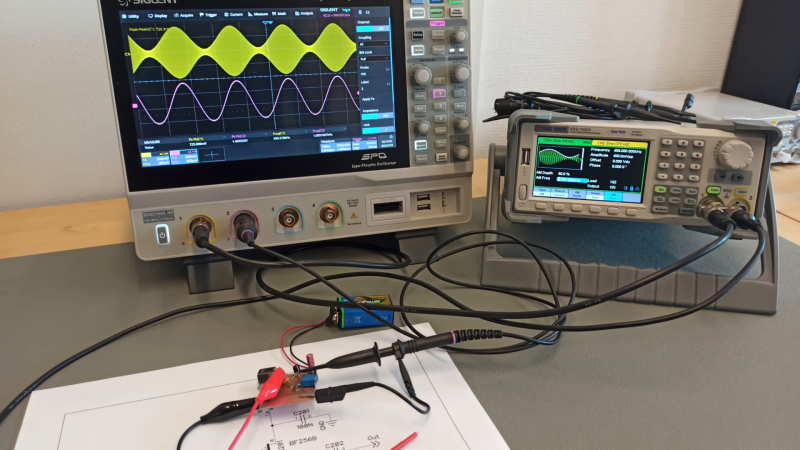An “Infinite Impedance Detector” might sound a little like something that [Zaphod Beeblebrox] would use to zip around the galaxy. It’s not, of course, but it is an interesting and useful demodulator for AM radio signals, as [Sebastian Westerhold] over at Baltic Labs explains in the brief but well-done video below.
If you’ve ever browsed through schematics of old vacuum tube radios, [Sebastian]’s JFET-based detector circuit might look strangely familiar. That’s because this demodulator is about as close to a direct translation between a vacuum tube circuit and a silicon circuit as possible. In fact, [Sebastian] even used literature from the triode version of this detector to figure out the values for some of the components. The only active component is a BF256B JFET; the rest are a small handful of resistors and caps. Construction is in the ever-popular ugly style.
The test setup is simple — a function generator set to 455 kHz and modulated with a 1,000 Hz sine wave. The detector demodulates the audio signal very cleanly, judging by the oscilloscope traces. Just for fun, [Sebastian] also tried a 10.7 MHz carrier with a 1,500 Hz audio modulation, and that worked fine too. He also tried a variation on the circuit with an IF transformer on the input. That circuit works just about the same as the transformerless version, although it does provide a little gain.
Earth-shattering stuff? Probably not. But it does show the fun you can have with a scrap of PCB and a few components, and seems like it could easily be the kind of project that would take you down the RF rabbit hole. Thanks to [Sebastian] for sharing this one with us.
















Yup … not earth shattering. A transconductance amplifier is a transconductance amplifier no matter what it physically looks like.
Nope … earth shattering. Not all transconductance amplifier implementations are alike i.e. an ideal one won’t work at all as AM demodulator.
With a 100 kilohm resistor to ground after the input coupling capacitor, the impedance is nowhere near infinite. As for the JFET itself, the gate is a junction biassed off when the device is in its active region, so its impedance is that of a small reversed biassed diode combined other factors: high but not infinite.
„Earth-shattering stuff? Probably not.“
— Well, maybe Turkey and Syria would somewhat disagree. Coincidence? I do not think so. Share before they delete this.
This can’t have much relevance today “AM is dead”. But people are skipping AM for FM. The kids all have black box SDRs so wouldn’t be interested. Ham radio has moved to SSB. Only the nouveau AMers would have an interest.
You could replace the jfet with a diode, right? At least as long as your signal is larger than the forward voltage.
And wouldn’t a MOSFET work the same way? Too slow because too capacitive?
The jfet provides a bit of gain compared to a diode but even without the DC-reject caps, the circuit appears to have less than -3 dB of gain on the scope.